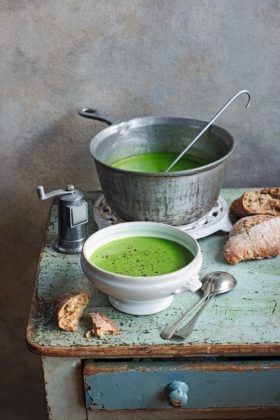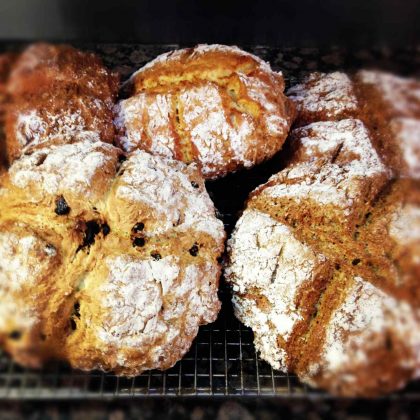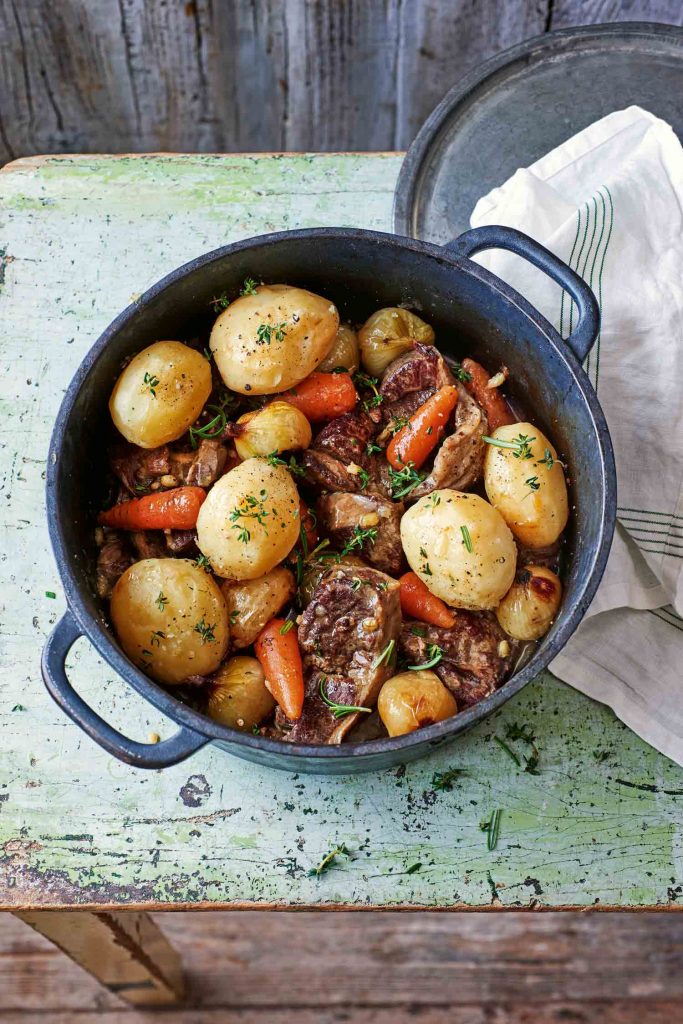1. Green Juice

Makes 450ml (15fl oz)
- 40g (1½oz) curly kale, weighed after stalks are removed
- 10g (½oz) coriander leaves
- 10g (½oz) flat parsley
- ½ tsp grated ginger
- freshly squeezed juice of ½ lemon
- 1 tbsp honey
- 600ml (1 pint) apple juice
Whizz all the ingredients together in a food processor
2. Wild Watercress Soup

Wild watercress has more depth of flavour than farmed versions, so see if you can find some. This soup has been a favourite on the menu of Ballymaloe House since it opened in 1963.
Serves 6-8
- 45g (1½ oz) butter
- 150g (5ozs) peeled and chopped potatoes
- 110g (4ozs) peeled and chopped onion
- Salt and freshly ground pepper
- 900ml (1½ pints) water or homemade chicken stock or vegetable stock
- 300ml (½ pint) creamy milk
- 225g (8ozs) chopped watercress (remove the coarse stalks first)
Melt the butter in heavy-bottomed saucepan, when it foams, add the potatoes and onions and toss them until well coated. Sprinkle with salt and freshly ground pepper. Cover and sweat on a gentle heat for 10 minutes. Meanwhile prepare the watercress. When the vegetables are almost soft but not coloured add the hot stock and boiling milk. Bring back to the boil and cook until the potatoes and onions are fully cooked. Add the watercress and boil with the lid off for 4-5 minutes approx until the watercress is just cooked. Do not overcook or the soup will lose its fresh green colour. Puree the soup in a liquidiser. Taste and correct seasoning.
3. Irish Soda Bread

Preheat the oven to 250℃/ 392°F
Makes 1 loaf
- 450g (1lb, 31/2 cups) plain flour
- 1/2 teaspoon sugar
- 1/2 teaspoon salt
- 1/2 teaspoon bicarbonate of soda
- 300-600ml (1/2 – 1 pint, 1 1/4 – 2 1/2 cups) sour milk or buttermilk
Sieve the dry ingredients. Make a well in the centre.
Pour in all the milk at once. Using 1 hand, with your fingers stiff and outstretched like a claw, stir in a full circular movement from the centre to the outside of the bowl in ever-increasing circles. The dough should be softish, not too wet and sticky. When it all comes together, turn it out onto a well-floured work surface. Wash and dry your hands. Tidy it up and flip over gently. Pat the dough into a round, about 4cm deep.
Cut a deep cross on the loaf and prick in the four corners.
Bake in the oven for 15 minutes then turn down to 200℃/ 392°F for 30 minutes until cooked. If you are in doubt, tap the bottom of the bread, when it is cooked it will sound hollow. Cool on a wire rack.
Tip! Soda breads are best eaten on the day they are made but are still good for a day or so more.
Variations:
Spotted Dog – Follow the recipe above adding: 1 dessertspoon of sugar 100g sultanas 1 egg Add the sugar and the sultanas with the flour and drop the egg in with the milk before missing. Spotted dog is also called railway cake in some parts of the country ‘a currant for each station’.
Stripy Cat – Follow the spotted dog recipe replacing the sultanas with 75g of roughly chopped best quality chocolate.
4. Irish Stew
Recipes for Irish Stew vary from family to family; it’s a one-pot meal, usually made with lamb or hogget, sometimes beef. It always includes onion and potatoes, but in east Cork, carrots are also added. This is Darina Allen’s west Cork version which is bulked out with swede turnips.
Serves 6-8
- 1.3kg gigot or rack chops from the shoulder of lamb not less than 2.5cm thick
- 450g carrots (4 medium), cut into 2.5cm chunks
- 450g (8 medium) onions
- 450g swede turnip, cut into 2.5cm cubes
- 10 -12 potatoes, or more if you like
- salt and freshly ground pepper
- 1litre stock (lamb stock if possible) or water
- 1 sprig of thyme
- 1 tbsp roux, optional
Garnish
- 1 tbsp freshly chopped parsley
- 1 tbsp freshly chopped chives
Preheat the oven to 180℃ /350℉/regulo 4.
Trim off the excess fat from the chops. Remove the bones and cut into generous 2.5cm cubes, you should have a minimum of 1.1kg lamb. Set aside. Render down the fat on a gentle heat in a heavy pan (discard the rendered down pieces).
Peel the onions and scrape or thinly peel the carrots (if they are young you could leave some of the green stalks on the onion and carrot). Cut the carrots into large chunks, or if they are small leave them whole. If the onions are large, cut them into quarters through the root, if they are small they are best left whole. Peel the turnip and cut into cubes.
Toss the meat in the hot fat on the pan until it is slightly brown. Transfer the meat into a casserole (add the bones also but discard later). Quickly toss the onions and carrots in the fat. Build the meat, carrots, onions and turnip up in layers in the casserole; carefully season each layer with freshly ground pepper and salt. De-glaze the pan with lamb stock and pour into the casserole. Peel the potatoes and lay them on top of the casserole, so they will steam while the stew cooks. Season the potatoes. Add a sprig of thyme, bring to the boil on top of the stove, cover with a butter wrapper or paper lid and the lid of the saucepan.
Transfer to a moderate oven or allow to simmer on top of the stove until the stew is cooked, 1-1½ hours approx, depending on whether the stew is being made with lamb or hogget. (If the potatoes are small, use twice as many and add halfway through cooking.)
When the stew is cooked, pour off the cooking liquid, de-grease and reheat in another saucepan. Discard the bones. Thicken slightly by whisking in a little roux. Check seasoning, and then add chopped parsley and chives. Pour over the meat and vegetables. Bring the stew back up to boiling point and serve from the pot, in a large pottery dish or in individual bowls.
Notice how the meat is taken off the bone for ease of service, but the bones are included during the cooking process to enhance the flavour and nourishment.




